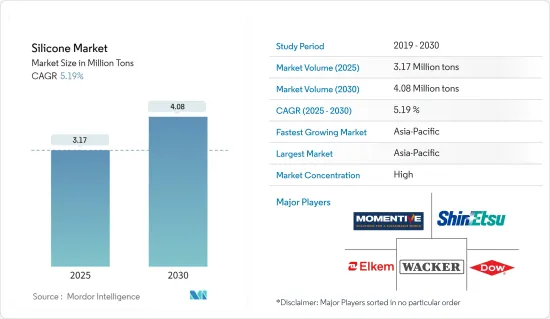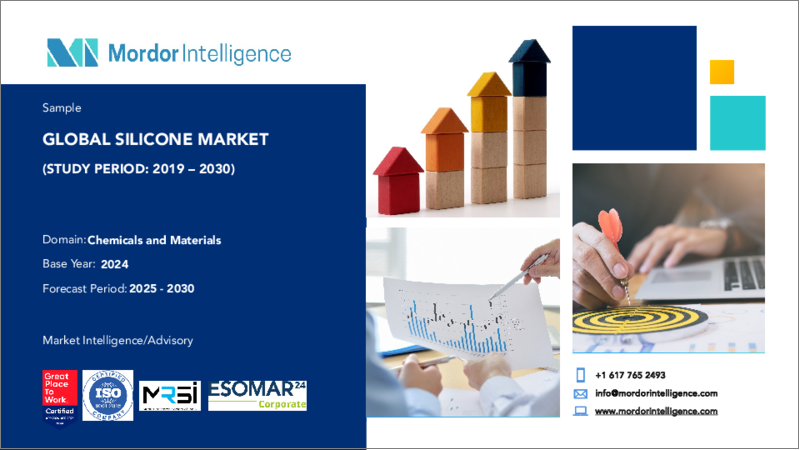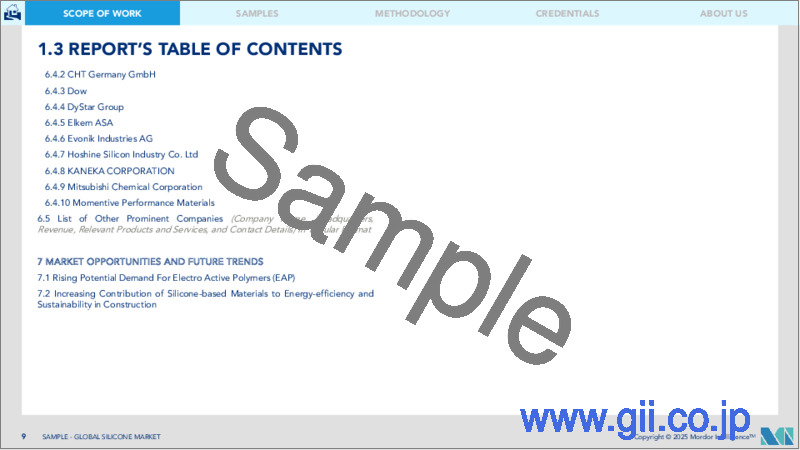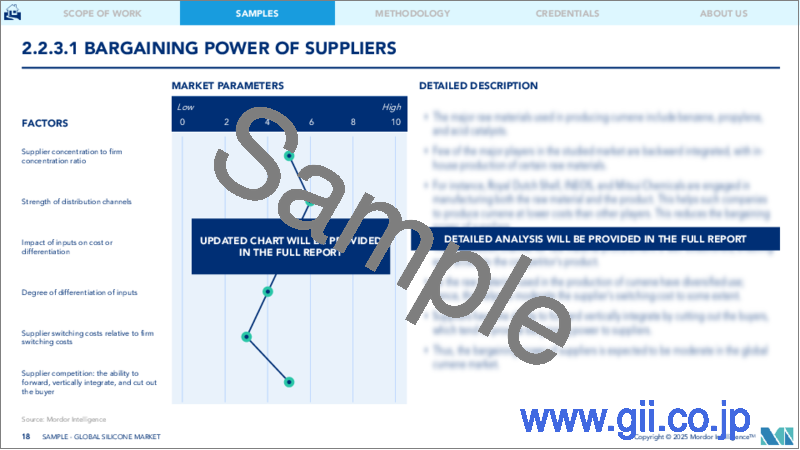|
|
市場調査レポート
商品コード
1686590
シリコーン:市場シェア分析、産業動向・統計、成長予測(2025~2030年)Silicone - Market Share Analysis, Industry Trends & Statistics, Growth Forecasts (2025 - 2030) |
||||||
カスタマイズ可能
適宜更新あり
|
|||||||
| シリコーン:市場シェア分析、産業動向・統計、成長予測(2025~2030年) |
|
出版日: 2025年03月18日
発行: Mordor Intelligence
ページ情報: 英文 120 Pages
納期: 2~3営業日
|
全表示
- 概要
- 目次
シリコーンの市場規模は2025年に317万トンと推計され、予測期間(2025~2030年)のCAGRは5.19%で、2030年には408万トンに達すると予測されています。

COVID-19はシリコーン市場を阻害しました。パンデミックの初期段階では、ロックダウンや移動制限がグローバルサプライチェーンを混乱させ、原料調達の遅れや生産停止につながりました。その結果、シリコーン製品が一時的に不足し、製造業務に影響が出ました。しかし、ロックダウン措置が緩和され、経済活動が再開されると、自動車、建設、エレクトロニクス、ヘルスケアなど様々な業界でシリコーンに対する莫大な需要が放出されるようになりました。
シリコーン市場を牽引している主な要因は、ヘルスケア産業におけるシリコーンの使用量の増加、送電と配電部門からの需要の増加、自動車産業におけるシリコーンの用途の増加です。
その反面、政府の規制や代替品との競合が市場成長の妨げになると予想されます。
様々なエンドユーザーからの電気活性ポリマー(EAP)に対する潜在的な需要の高まりと、建設におけるエネルギー効率と持続可能性に対するシリコーンベースの材料の貢献の増加は、予測期間中にシリコーン市場の機会として作用すると思われます。
アジア太平洋地域は他の地域の中でシリコーン市場を独占すると予想され、中国とインドがこの地域の成長をリードしています。
シリコーン市場動向
市場を独占する工業プロセス部門
- 製造プロセス分野におけるシリコーンの主な用途には、消泡剤、工業用コーティング剤、流体、オイル、常温加硫シーラント、成形品、ポリマー用添加剤などがあります。
- シリコーンは、スペースや重量の制限から海洋掘削で広く使用されており、泡や廃棄物の管理が不可欠です。シリコーンは、掘削泥水に閉じ込められたガスを放出させます。泡の存在は作業の妨げとなり、メンテナンス作業に時間を要するため、消泡剤はエネルギー消費量と化学物質の使用量を削減すると同時に、生産量を向上させます。
- このように、世界の石油・ガス産業の拡大は、シリコーン需要の恩恵を受けると予想されています。現在進行中の様々な拡張プロジェクトが成長を促進すると予想されます。インドはアジア太平洋地域の石油・ガス分野で重要な経済圏です。インド・ブランド・エクイティ財団(IBEF)が発表した報告書によると、インドの石油需要は2045年までに1,100万バレルに達すると予測されています。また、インドの天然ガス消費量は2024年末までに250億立方メートル増加すると予想されています。
- さらに、Energy Instituteが発表したデータによると、2022年の世界の石油生産量は44億720万トンに達しました。
- また、石油輸出国機構(OPEC)が発表した報告書によると、原油需要は増加しており、2023年には日量1億189万バレルに増加しました。これは石油・ガス産業からのシリコーン需要の増加につながります。
- 2023年、世界最大の原油輸入国である中国は、中国の税関のデータによると、1日当たり1,130万バレルの原油を輸入し、前年から10%増加しました。中国の製油所では、輸送用燃料の需要を満たし、拡大する石油化学製品の原料を生産するために、2023年に最も多くの原油が輸入されました。
- 以上のような要因から、予測期間中、市場は回復後の堅調な成長が見込まれます。
アジア太平洋が市場を独占する見込み
- アジア太平洋地域はシリコーンの最大消費国であり、中国、インド、日本の市場が同地域の成長を牽引しています。
- 半導体はエレクトロニクス分野の重要な部品の一つであり、半導体、PCB、ECUの保護にシリコーンが封入、被覆、付着されるため、シリコーンが使用されます。半導体産業協会と世界半導体貿易統計(WSTS)によると、2023年1月の中国の半導体販売額は116億6,000万米ドルでした。
- さらに、中国には、China Shipbuilding Industry Corporation(CSIC)、China State Shipbuilding Corporation(CSSC)、COSCO shipping、CMHI、Sinotransなど、複数の大手造船コングロマリットがあります。中国の造船所は、貨物船、コンテナ船、石油タンカー、艦艇、旅客船、豪華客船など、多種多様な船舶を建造しており、これがシリコンの需要につながっています。
- また、インドブランドエクイティ財団(IBEF)によると、インドにおける半導体製品の需要は、2025年度までに4,000億米ドルに達すると予想されています。また、ウッタル・プラデーシュ州政府は、生産連動奨励金制度により、インドがチップ産業への投資として76,000カロールインドルピー(90億9,366万米ドル)の恩恵を受けると推定されていることから、同国の半導体ハブになることを目指しています。
- 中国の家電製品市場は、2024年にプラス成長で回復します。中国の家電製品の小売総売上高は2兆2,000億人民元(3,050億米ドル)に達すると予想され、成長率は2024年にはさらに5%まで上昇すると見込まれています。
- このように、上記の要因が予測期間中のアジア太平洋におけるシリコーン需要の増加に寄与すると予想されます。
シリコーン業界の概要
シリコーン市場は統合されています。主要企業(順不同)には、Wacker Chemie AG、Dow、Shin-Etsu Chemical、Momentive、Elkem ASAが含まれます。
その他の特典
- エクセル形式の市場予測(ME)シート
- 3ヶ月のアナリストサポート
目次
第1章 イントロダクション
- 調査の前提条件
- 調査範囲
第2章 調査手法
第3章 エグゼクティブサマリー
第4章 市場力学
- 促進要因
- 自動車産業における用途の増加
- ヘルスケア産業での用途拡大
- 送電・配電分野での需要増加
- 抑制要因
- 政府の規制
- 代替品との競合
- バリューチェーン分析
- ポーターのファイブフォース分析
- 供給企業の交渉力
- 買い手の交渉力
- 新規参入業者の脅威
- 代替品の脅威
- 競合の程度
第5章 市場セグメンテーション
- フォーム別
- エラストマー
- 流体
- 樹脂
- その他
- エンドユーザー別
- 輸送
- 建設資材
- エレクトロニクス
- ヘルスケア
- 工業プロセス
- パーソナルケア・消費者製品
- その他のエンドユーザー(繊維・コーティング)
- 地域別
- アジア太平洋
- 中国
- インド
- 日本
- 韓国
- タイ
- マレーシア
- インドネシア
- ベトナム
- ASEAN諸国
- その他アジア太平洋地域
- 北米
- 米国
- カナダ
- メキシコ
- 欧州
- ドイツ
- 英国
- イタリア
- フランス
- スペイン
- トルコ
- ロシア
- ノルディック
- その他欧州
- 南米
- ブラジル
- アルゼンチン
- コロンビア
- その他南米
- 中東・アフリカ
- サウジアラビア
- 南アフリカ
- ナイジェリア
- カタール
- エジプト
- アラブ首長国連邦
- その他中東とアフリカ
- アジア太平洋
第6章 競合情勢
- M&A、合弁事業、提携、協定
- 市場シェア(%)**/ランキング分析
- 主要企業の戦略
- 企業プロファイル
- BRB International(PETRONAS Chemicals Group Berhad)
- CHT Germany GmbH
- Dow
- DyStar Singapore Pte Ltd
- Elkem ASA
- Evonik Industries AG
- Hoshine Silicon Industry Co. Ltd
- Jiangsu Mingzhu Silicone Rubber Material Co. Ltd
- KANEKA CORPORATION
- Mitsubishi Chemical Corporation
- Momentive
- Shin-Etsu Chemical Co. Ltd
- Wacker Chemie AG
- Wynca Tinyo Silicone Co. Ltd
- Zhejiang Sucon Silicone Co. Ltd
第7章 市場機会と今後の動向
- 電気活性ポリマー(EAP)に対する潜在需要の高まり
- 建設におけるエネルギー効率と持続可能性へのシリコーン系材料の貢献の増大
The Silicone Market size is estimated at 3.17 million tons in 2025, and is expected to reach 4.08 million tons by 2030, at a CAGR of 5.19% during the forecast period (2025-2030).

COVID-19 hampered the silicone market. During the early stages of the pandemic, lockdowns and restrictions on movement disrupted global supply chains, leading to delays in raw material procurement and production shutdowns. This resulted in temporary shortages of silicone products and impacted manufacturing operations. However, as lockdown measures eased and economic activities resumed, enormous demand for silicone was released across various industries such as automotive, construction, electronics, and healthcare.
The major factors driving the silicone market are the increased usage of silicone in the healthcare industry, the growing demand from the power transmission and distribution segment, and rising applications of silicone in the automotive industry.
On the flip side, government regulations and competition from substitutes are expected to hinder the growth of the market.
Rising potential demand for electroactive polymers (EAP) from various end users and increasing contribution of silicone-based materials to energy efficiency and sustainability in construction are likely to act as an opportunity in the silicone market during the forecast period.
Asia-Pacific is expected to dominate the silicone market among other regions, with China and India leading the region's growth.
Silicone Market Trends
The Industrial Processes Segment to Dominate the Market
- The main applications of silicones in the field of manufacturing processes include antifoaming agents, industry coatings, fluids and oils, room-temperature vulcanizing sealants, moldings, and additives for polymers.
- Silicones are widely used in offshore drilling because of space and weight limitations, where the management of foam and waste is essential. Silicones allow the gas trapped in the drilling mud to be released. Due to the presence of foam, which hinders the process and requires time for maintenance work, antifoaming agents reduce energy consumption and chemical use while boosting production.
- Thus, expanding the global oil and gas industry is anticipated to benefit from the demand for silicone. Various expansion projects underway are expected to drive the growth. India is a significant economy in Asia-Pacific in the oil and gas segment. According to the report released by the India Brand Equity Foundation (IBEF), the oil demand in India is projected to reach 11 million barrels by 2045. In addition, India's natural gas consumption is expected to increase by 25 billion cubic meters by the end of 2024.
- Moreover, according to the data published by the Energy Institute, global oil production reached 4,407.2 million metric tons in 2022.
- Also, according to the report released by the Organization of the Petroleum Exporting Countries (OPEC), there is a rise in demand for crude oil, which increased to 101.89 million barrels per day in 2023. This leads to increased demand for silicone from the oil and gas industries.
- In 2023, China, the globe's top importer of crude oil, brought in 11.3 million barrels of crude oil daily, marking a 10% rise from the previous year, as per data from China's customs. Refineries in China saw their highest crude oil imports in 2023 to meet the nation's rising demand for refining, aiming to meet transportation fuel needs and generate raw materials for its expanding petrochemical.
- Due to all the above factors, the market is expected to witness post-recovery solid growth during the forecast period.
Asia-Pacific is Expected to Dominate the Market
- Asia-Pacific is the largest consumer of silicone, with the Chinese, Indian, and Japanese markets driving growth in the region over the years.
- Semiconductors are one of the significant parts of the electronics segment, which involves the usage of silicones as silicone encapsulates, coats, and adheres to the protection of semiconductors, PCBs, and ECUs. According to the Semiconductor Industry Association and the World Semiconductor Trade Statistics (WSTS), the semiconductor sales value in China stood at USD 11.66 billion in January 2023.
- Moreover, China has several large shipbuilding conglomerates, including China Shipbuilding Industry Corporation (CSIC), China State Shipbuilding Corporation (CSSC), COSCO shipping, CMHI, and Sinotrans. China's shipyards build a wide variety of ships, including freighters, containerships, oil tankers, naval vessels, passenger craft, luxury carriers, and so on, which leads to the demand for silicone.
- Also, according to the India Brand Equity Foundation (IBEF), the demand for semiconductor goods in India is expected to be USD 400 billion by FY 2025. The Government of Uttar Pradesh also aims to become a semiconductor hub in the country, given that India is estimated to benefit from INR 76,000 crore (USD 9,093.66 million) as an investment into the chip industry under the Production Linked Incentive scheme.
- China's consumer electronics market is set to bounce back with positive growth in 2024, driven by growing market demand and innovation while increasing retail spending. China's total retail sales of consumer electronics are expected to reach CNY 2.2 trillion (USD 305 billion), and the growth rate is expected to increase further to 5% in 2024.
- Thus, the above-mentioned factors are expected to contribute to the increasing demand for silicone in Asia-Pacific during the forecast period.
Silicone Industry Overview
The silicone market is consolidated. The major players (not in any particular order) include Wacker Chemie AG, Dow, Shin-Etsu Chemical Co. Ltd, Momentive, and Elkem ASA.
Additional Benefits:
- The market estimate (ME) sheet in Excel format
- 3 months of analyst support
TABLE OF CONTENTS
1 INTRODUCTION
- 1.1 Study Assumptions
- 1.2 Scope of the Study
2 RESEARCH METHODOLOGY
3 EXECUTIVE SUMMARY
4 MARKET DYNAMICS
- 4.1 Drivers
- 4.1.1 Rising Application in Automotive Industry
- 4.1.2 Increasing Usage in Healthcare Industry
- 4.1.3 Growing Demand from Power Transmission and Distribution
- 4.2 Restraints
- 4.2.1 Government Regulation
- 4.2.2 Competition from Substitutes
- 4.3 Industry Value Chain Analysis
- 4.4 Porter's Five Forces Analysis
- 4.4.1 Bargaining Power of Suppliers
- 4.4.2 Bargaining Power of Buyers
- 4.4.3 Threat of New Entrants
- 4.4.4 Threat of Substitute Products and Services
- 4.4.5 Degree of Competition
5 MARKET SEGMENTATION (Market Size in Volume)
- 5.1 Form
- 5.1.1 Elastomers
- 5.1.2 Fluids
- 5.1.3 Resins
- 5.1.4 Other Forms
- 5.2 End User
- 5.2.1 Transportation
- 5.2.2 Construction Materials
- 5.2.3 Electronics
- 5.2.4 Healthcare
- 5.2.5 Industrial Processes
- 5.2.6 Personal Care and Consumer Products
- 5.2.7 Other End Users (Textiles and Coatings)
- 5.3 Geography
- 5.3.1 Asia-Pacific
- 5.3.1.1 China
- 5.3.1.2 India
- 5.3.1.3 Japan
- 5.3.1.4 South Korea
- 5.3.1.5 Thailand
- 5.3.1.6 Malaysia
- 5.3.1.7 Indonesia
- 5.3.1.8 Vietnam
- 5.3.1.9 ASEAN Countries
- 5.3.1.10 Rest of Asia-Pacific
- 5.3.2 North America
- 5.3.2.1 United States
- 5.3.2.2 Canada
- 5.3.2.3 Mexico
- 5.3.3 Europe
- 5.3.3.1 Germany
- 5.3.3.2 United Kingdom
- 5.3.3.3 Italy
- 5.3.3.4 France
- 5.3.3.5 Spain
- 5.3.3.6 Turkey
- 5.3.3.7 Russia
- 5.3.3.8 NORDIC
- 5.3.3.9 Rest of Europe
- 5.3.4 South America
- 5.3.4.1 Brazil
- 5.3.4.2 Argentina
- 5.3.4.3 Colombia
- 5.3.4.4 Rest of South America
- 5.3.5 Middle East and Africa
- 5.3.5.1 Saudi Arabia
- 5.3.5.2 South Africa
- 5.3.5.3 Nigeria
- 5.3.5.4 Qatar
- 5.3.5.5 Egypt
- 5.3.5.6 United Arab Emirates
- 5.3.5.7 Rest of Middle East and Africa
- 5.3.1 Asia-Pacific
6 COMPETITIVE LANDSCAPE
- 6.1 Mergers and Acquisitions, Joint Ventures, Collaborations, and Agreements
- 6.2 Market Share (%)**/Ranking Analysis
- 6.3 Strategies Adopted by Leading Players
- 6.4 Company Profiles
- 6.4.1 BRB International (PETRONAS Chemicals Group Berhad)
- 6.4.2 CHT Germany GmbH
- 6.4.3 Dow
- 6.4.4 DyStar Singapore Pte Ltd
- 6.4.5 Elkem ASA
- 6.4.6 Evonik Industries AG
- 6.4.7 Hoshine Silicon Industry Co. Ltd
- 6.4.8 Jiangsu Mingzhu Silicone Rubber Material Co. Ltd
- 6.4.9 KANEKA CORPORATION
- 6.4.10 Mitsubishi Chemical Corporation
- 6.4.11 Momentive
- 6.4.12 Shin-Etsu Chemical Co. Ltd
- 6.4.13 Wacker Chemie AG
- 6.4.14 Wynca Tinyo Silicone Co. Ltd
- 6.4.15 Zhejiang Sucon Silicone Co. Ltd
7 MARKET OPPORTUNITIES AND FUTURE TRENDS
- 7.1 Rising Potential Demand For Electro Active Polymers (EAP)
- 7.2 Increasing Contribution of Silicone-based Materials to Energy-efficiency and Sustainability in Construction





